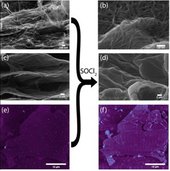Highlight
Highly Conductive Transparent Films Based on Graphene and Carbon Nanotubes
Achievement/Results
With the support of the National Science Foundation IGERT program, Kitty Cha, a graduate student from the group of Professor Yang Yang, along with collaborators from the group of Professor Richard Kaner, has employed a simple chemical modification method to dramatically increase the conductivity of solution-processed composite films of graphene and carbon nanotubes. Graphene and carbon nanotubes have been lauded as potential candidates for applications in next-generation optoelectronic devices because of their remarkable electronic properties. The ability to deposit these materials using solution-based methods dramatically lowers their processing costs. The conductivities from these materials have to be high in order for them to effectively replace indium tin oxide (ITO) as a transparent electrode in commercial devices.
Thionyl chloride (SOCl2), a widely used reagent in organic reactions, was found to effectively increase the electrical conductivity of solution-deposited chemically reduced graphene-carbon nanotubes by a factor of four. A spectroscopic study of the effects of the chemical dopant found that the thionyl chloride withdraws electrons from the graphitic bases of graphene and carbon nanotubes via C-Cl bonding, effectively hole-, or p-doping the film. UV-visible absorbance spectroscopy showed that the transmittances of these films before and after chemical modification were comparable. Microscopic studies showed that there was also a morphological change in the composites after SOCl2 treatment. Films that measured ~400 Ω/sq. before chemical doping at 82% transmittance were 105 Ω/sq. after doping, at similar transmittance. For comparison, high-quality ITO measures tens of Ω/sq. at over 90% transmittance. This achievement brings carbon nanomaterials significantly closer to being a viable option for replacement of ITO in electronic devices.
Reference
Jonathan K. Wassei, Kitty C. Cha, Vincent C. Tung, Yang Yang and Richard B. Kaner
The effects of thionyl chloride on the properties of graphene and graphene-carbon nanotube composites. J. Mater. Chem., 2011, 21, 3391-3396.
Address Goals
The ability to achieve this conductivity with solution-processed reduced graphene and carbon nanotubes allows the scientific community to consider this material as another transparent conducting material that is widely abundant with scalable processibility. The study of this doping process provides insight into the way these materials are manipulated to provide higher conductivities, which will enable selection of different materials for more effective doping of graphene and carbon nanotubes.







